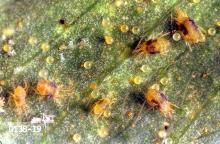Banks grass mite (Oligonychus pratensis) Tetranychus spp.
Pest description and crop damage These spider mites typically infest timothy hay or timothy- alfalfa mixed-stand hay crops. Infestation leads to silvering and stunting of hay crop ultimately reducing yield especially in timothy hay.
Management-chemical control
- chlorantraniliprole/lambda-cyhalothrin (Besiege, Voliam Xpress) at 0.0391 to 0.0652 lb ai/A for chlorantraniliprole and 0.0195 to 0.0325 lb ai/A for lambda-cyhalothrin. PHI 0 days for grazing or cut for forage; 7 days for cut grass to be dried and harvested for hay. Retreatment interval 7 days. REI 12 hr. Do not exceed 0.09 lb ai/A lambda-cyhalothrin or 0.2 lb ai/A chlorantraniliprole. Suppression only.
- gamma-cyhalothrin (Declare) at 0.01 to 0.015 lb ai/A. PHI 0 days for grazing or cut for forage; 7 days for cut grass to be dried and harvested. REI 24 hr. Do not exceed 0.045 lb ai/A per season. Suppression only.
- hexythiazox (Ruger EC) at 0.078 to 0.188 lb ai/A. PHI 14 days. REI 12 hr. Limit 1 treatment per year. Timothy only.
- malathion (Malathion 5EC) at 1.25 lb ai/A. PHI 0 days. REI 12 hr. One application limit per cutting.
Management-biological control
- Natural enemies such as the predatory mites including:
- Western predatory mite (Galendromus occidentalis)
- Phytoseiulus predatory mite spp. (Neoseiulus californicus)
- Various other predatory insects such as sixspotted thrips (Scolothrips sexmaculatus), spider mite destroyer lady beetle (Stethorus picipes)
Management-cultural control
- Early irrigation management to maintain cooler, more humid microclimate in the crop discourages mite development. Note: Water stressed plants tend to be less tolerant to mite damage.


